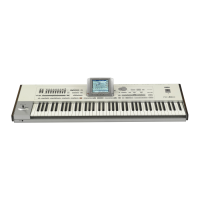165
Song Play operating mode
Jukebox panel
Reference
Slider Mode button status
The function assigned to the Assignable Sliders depends on the
status of the SLIDER MODE button. Note that this may change
when selecting a different Performance or STS.
For details about the various Slider Modes, see “SLIDER
MODE” on page 7.
Track status icons
Play/mute status of the current track. Select the track, then
touch this area to change its status.
Play status. The track can be heard.
Mute status. The track cannot be heard.
Saving the track’s status
• The status of Keyboard tracks may be saved to a Performance
or STS, and can be changed when choosing a different Perfor-
mance or STS (see “Write Performance” on page 111 and “Write
Single Touch Setting” on page 111).
• The status of the Song tracks can be saved as a general setting
into the Global-Song Play Setup (by choosing the “Write Global-
Song Play Setup” command from the page menu, see (see “Write
Global-Song Play Setup dialog box” on page 181). Settings for
each Player can be different.
This allows for leaving the track status unchanged even when
playing a different Standard MIDI File. You can leave, for exam-
ple, the bass track in mute, and let your bassist play it live for the
whole show.
However, an exception to the above is when reading a Standard
MIDI File created with a Pa-Series instrument. These files do
include special commands to force the Play/Mute status of each
track.
Track names
Under the sliders, a label for each track is shown. Use the TRK.
SEL button to switch between the various track views.
Jukebox panel
When a Jukebox (JBX) file is assigned to Player 1, you can use
the list shown in this panel to browse the Jukebox list, and touch
the Select button in the display to select a Song to play. This way,
you can select any Song in the list as your starting Song, and
manually change the order of the Songs to play.
Note: A Jukebox file can be assigned to Player 1 only.
Note: This panel is only available after loading a Jukebox file.
Hint: To create or edit a Jukebox file, go to the Jukebox Edit page
(see page 176). A quick way to create a Jukebox list is to touch the
“Play All” button in the Song Select window (see page 85).
Warning: If you delete a Song included in the Jukebox list currently
in play, the player will stop, and the “No Song” message will
appear. At this point, you can select the JukeBox tab to open the
Jukebox panel, and select a different Song.
As an alternative, you can select the next Song by pressing SHIFT +
>> (FAST FORWARD) in the PLAYER 1 section of the control
panel, then press (PLAY/STOP) in the PLAYER 1 section
again.
Song list
Use this list to browse through the Songs in the Jukebox list. Use
the scrollbar to scroll the list.
Selected Song
Name of the Song currently in play. You can select a different
Song from the list, and touch the Select button in the display to
select it for playback.
Select button
Touch this button to select the Song highlighted in the list, and
assign it to Player 1. If a Song is already playing, it will be
stopped, and the selected Song will start playing back.
Jukebox file
Name of the selected Jukebox file. To edit this file, see “Jukebox
Editor” on page 176.
Transport controls for the Jukebox
When you select a Jukebox file, Player 1 transport controls work
in a slightly different way than with single Songs.
<< and >> Pressed alone, these buttons are the Rewind and
Fast Forward commands.
Keep the SHIFT button pressed, and press
these buttons to scroll to the previous or next
Song in the Jukebox list.
Abbreviation Track
MIC/IN Mic Audio input. Volume and play/mute status
not memorized.
UPPER1…3 Upper tracks. Volume and play/mute status
memorized into a Performance or STS.
LOWER Lower track. Volume and play/mute status
memorized into a Performance or STS.
T01…T16 Song tracks. Volume memorized into a Stan-
dard MIDI File. Play/mute status memorized as
a general setting into the Global – Song Play
Setup (different for each Player).
Sng
Track status icons
Song list Jukebox fileSelected Song

